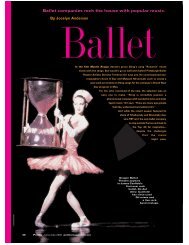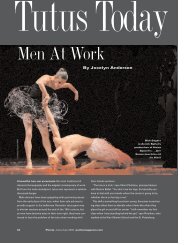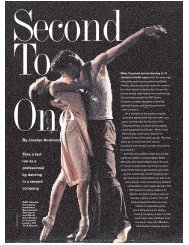A Day In The Life Of - About Me | Jocelyn Anderson
A Day In The Life Of - About Me | Jocelyn Anderson
A Day In The Life Of - About Me | Jocelyn Anderson
Create successful ePaper yourself
Turn your PDF publications into a flip-book with our unique Google optimized e-Paper software.
A <strong>Day</strong> <strong>In</strong> <strong>The</strong> <strong>Life</strong> <strong>Of</strong><br />
<strong>Anderson</strong><br />
Villella<br />
EdwardBy <strong>Jocelyn</strong><br />
Photography By Jeffery Salter<br />
Pointe follows<br />
Artistic Director<br />
Edward Villella<br />
as his company,<br />
Miami City<br />
Ballet, prepares<br />
for another<br />
opening night.<br />
42
Edward Villella is notorious for eating standing up.<br />
<strong>The</strong> founder and artistic director of Miami City Ballet—a<br />
company that performs the same program in four different<br />
counties—says most of the time he must take advantage<br />
of those brief moments when he can.<br />
That’s what he’s doing on this Friday in early<br />
November. He’s arrived at the Jackie Gleason <strong>The</strong>ater in<br />
Miami Beach, where the company is getting ready for<br />
the opening night of a triple bill featuring George<br />
Balanchine’s Divertimento No. 15, Trey Mc<strong>In</strong>tyre’s <strong>The</strong><br />
Reassuring Effects of Form and Poetry and Paul Taylor’s<br />
Piazzolla Caldera. I will be his shadow on this busy day<br />
as he interacts with his dancers, staff, donors and fans.<br />
“Today is just crazy,” Villella says, eating a sandwich<br />
in his dressing room. “Any opening is the same. It’s just<br />
nonstop.” This is the second such day in one week for<br />
MCB, which premiered the same program the weekend<br />
before in Fort Lauderdale.<br />
Earlier this morning, Villella stopped by the MCB<br />
offices to return phone calls and catch up with the<br />
administrative staff. Now, it’s 12:30 pm and, after a few<br />
more bites, he heads downstairs to the stage to teach<br />
company class, a requirement for MCB’s 48 dancers.<br />
Pointe February/March 2005 pointemagazine.com 43
Villella teaches<br />
company class.<br />
“I think a company should reflect the manner and style of its artistic<br />
director,” Villella says. “And the most consistent way I can do that is by<br />
teaching company class. Essentially, it’s taking a harmonious signature<br />
approach to gesture, so it looks like a company. <strong>The</strong> dancers know where<br />
I come from and what I am attempting to do.”<br />
I sit in the wings stage right and watch the dancers at the barres<br />
onstage. I can tell that musicality is very important in this company.<br />
Founded in 1985, MCB started with a plethora of Balanchine works,<br />
which Villella danced for 20 years as a principal at New York City Ballet.<br />
Villella made it a mission to bring that neoclassical style to southern<br />
Florida and introduce audiences there to the legendary choreographer’s<br />
sophisticated musical structures.<br />
<strong>In</strong> class, Villella offers exercises with difficult syncopated beats and<br />
claps his hands against his thighs to help the dancers keep time. Clad in<br />
black jeans, a light blue dress shirt and dance sneakers, he moves across<br />
the stage with the flair of someone who’s listening to his favorite song on<br />
the radio.<br />
At 68, Villella is amazingly spry. He has been very frank about how, as<br />
a dancer, he never properly warmed up his body. As a result, he’s had<br />
three hip replacements, nine broken toes, stress fractures in both legs<br />
and a bad back. “I’ve been around the block,” he says simply. “You don’t<br />
walk away easily from this stuff.”<br />
<strong>The</strong> prospect of a more-than-10-hour day can be daunting, but he<br />
knows what has to be done. He’s determined to be a hands-on director,<br />
which means that he will be at the theater whenever the dancers are there.<br />
After a 50-minute barre, Villella teaches a center. He gives the<br />
women piqué and fouetté turns and the men jumping exercises. He also<br />
takes the opportunity to finish his sandwich.<br />
<strong>In</strong> the<br />
dressing<br />
room<br />
44 Pointe February/March 2005 pointemagazine.com
“Any opening is the same.<br />
It’s just nonstop.” —Edward Villella
Clockwise from top left:<br />
Villella at pre-performance<br />
talk, technical<br />
rehearsal, reception,<br />
Piazzolla Caldera,<br />
flowers backstage,<br />
Divertimento No. 15
Villella congratulates<br />
the dancers after<br />
the performance.<br />
Class ends at 2 pm, and Villella gets the only break he’ll<br />
have all day. He spends it in his dressing room reading <strong>The</strong><br />
New York Times. A native of Queens, NY, and a longtime resident<br />
of NYC, he still likes to catch up on the news from home.<br />
At 2:30 pm, we move to seats in the house for the technical<br />
rehearsal. <strong>In</strong> addition to finalizing the lighting, this is a chance<br />
for Villella and the ballet mistresses, Iliana Lopez and Roma<br />
Sosenko, to address last-minute issues. Dancers get a chance<br />
to fine-tune and double-check positions.<br />
“We have not only had our rehearsal and dress rehearsal,<br />
but four performances [last week],” Villella says. “So now<br />
when we come here, I think that everyone is prepared. Now,<br />
it’s really just placing it on the stage and keeping an eye on<br />
detail and style, period and musicality.”<br />
<strong>The</strong> dancers run through the program in the order in which<br />
they will dance the ballets later that evening. For the most part,<br />
everyone dances full out, and it’s amusing to see half the cast of<br />
Divertimento in tutus and the other half in their warm-up clothes.<br />
Those who aren’t dancing sit in the aisles, stretch and applaud<br />
the solos. <strong>The</strong> massage therapist also sets up shop backstage<br />
for those who need her services.<br />
Everything goes smoothly, and the dancers congregate<br />
onstage for notes before going onto the next two pieces. “Like<br />
in Divertimento, [one dancer] held her passé too long and then<br />
she was late,” Villella tells me. “Those are the intricasies and<br />
the details. It’s mostly reminding. <strong>The</strong>re are so many things you<br />
have to be aware of when you are onstage.”<br />
Villella has programmed a wide-ranging lineup for this<br />
evening. Divertimento, set to the music of Mozart, features<br />
tutus, while Piazzolla Caldera is an Argentinean tango with<br />
men and women in character shoes. Sandwiched between the<br />
two is Mc<strong>In</strong>tyre’s free-form contemporary work.<br />
<strong>The</strong> stage rehearsal ends at 5:30 pm, and Villella returns to<br />
his dressing room to change his clothes. He quickly puts on a<br />
checkered double-breasted suit, taking a moment to tame his<br />
still-brown mane. His wife, Linda (who is also the director of the<br />
MCB School), has called to say she will soon arrive at the theater.<br />
Together, we drive a couple blocks to attend a special<br />
reception that starts at 6 pm for company donors who have<br />
contributed $1,500 or more. <strong>The</strong> party is held at Pacific Time,<br />
an old restaurant on Lincoln Road, a trendy shopping and dining<br />
street. <strong>The</strong>re, Villella chats with donors and eats a few hors<br />
d’oeuvres before he has to hotfoot it back to the theater to give<br />
his pre-performance talk at 7:15 pm.<br />
Before every performance, Villella speaks to the audience<br />
about the evening’s program and answers questions. “It accomplishes<br />
two things,” he says. “It makes the audience more aware<br />
of what they are going to see and it also humanizes this stuff.<br />
“I brought a rep here 18 years ago that was unfamiliar<br />
to this community. <strong>The</strong>y had been very accustomed to 19thcentury<br />
spectacle. I wanted to start with Balanchine because<br />
it’s the most difficult.” As the repertoire has grown to include other<br />
works—seven premières this season—his own choreography<br />
and even the occasional Giselle or Coppélia, he has continued<br />
to introduce every performance.<br />
<strong>The</strong> curtain rises at 8 pm, and Villella takes a seat next to<br />
Linda on the aisle in row M. “I try to sit back and enjoy it,” he<br />
says. “By the same token, I allow myself to critique.” If he notices<br />
something that needs fixing, he’ll bring it up the next day or<br />
possibly break it down in the next company class.<br />
By this hour, Villella’s energy hasn’t flagged. He springs up<br />
at each intermission to run backstage before making an<br />
appearance in the VIP room. He is able to grab a quick drink<br />
and a few more hors d’oeuvres before he is due back in his seat.<br />
After the third ballet ends at 10:20 pm, I follow Villella<br />
backstage before the crowd has even finished applauding. He<br />
tells me that he likes to be available to the dancers before and<br />
after every performance.<br />
“[Before the show] I just go to them,” Villella says, “kiss<br />
them and say, ‘Have a good time. Have a wonderful experience.<br />
You’re prepared. You understand who you are. Show us.’<br />
Afterward, I come back and I say, ‘Thank you.’” P<br />
Pointe February/March 2005 pointemagazine.com 47








